
Miracle®
Powerful and intuitive modern software designed specifically for the IR5
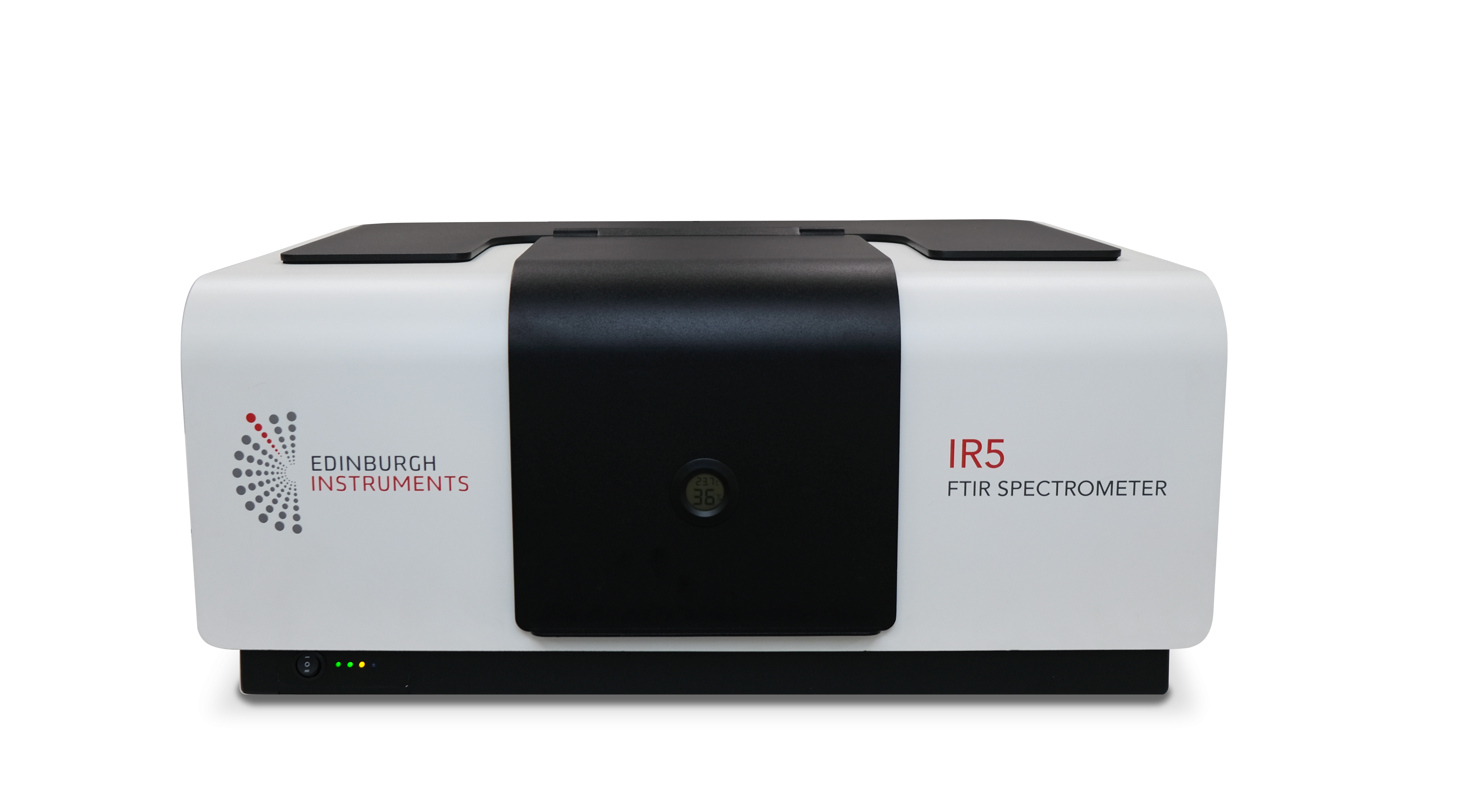
Send us your samples, and we can measure them live in an online demonstration
Contact us to arrange an online demonstration

Miracle®

Maintenance Free

Photoluminescence Upgrade

Dedicated Team
"*" indicates required fields
The IR5 FTIR Spectrometer stands as a pinnacle of analytical instrumentation, tailored for precise and comprehensive infrared spectroscopy. It offers researchers and analysts across diverse industries an indispensable tool for probing molecular structures and compositions with unrivalled accuracy.
The IR5 demonstrates exceptional versatility, effortlessly adapting to applications across polymers, pharmaceuticals, semiconductors, and more. Unique to the IR5 is the option to incorporate a second detector in its class of FTIR spectrometers, eliminating the need for multiple systems. The additional detector can be chosen to provide increased sensitivity in specific spectral ranges. This ensures seamless transition from routine analysis to demanding tasks requiring utmost sensitivity.
Beyond its technical excellence, the IR5 is designed for ease of use and efficiency in laboratory settings. Equipped with intuitive software, Miracle™, it enables straightforward measurement of IR absorption, transmission, reflectance, and photoluminescence—all through a single user-friendly interface.
Whether conducting routine quality control assessments or investigating complex research projects, the IR5 FTIR Spectrometer empowers scientists with rapid data acquisition capabilities and robust analytical performance. With its compact benchtop design and maintenance-free operation, the IR5 represents a reliable partner in advancing scientific discoveries and ensuring the highest standards of analytical precision.
Miracle™ software package is designed specifically for the IR5 FTIR spectrometer with a focus on ease of use and smooth workflow. Miracle controls every aspect of your experiment, from instrument setup to data acquisition, analysis and reporting, ensuring intuitive operation at every step.
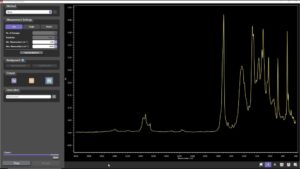
Figure 1: Miracle software interface
Miracle package offers two user levels making it suitable to a wide range of applications. Standard user mode is optimal for analysis and teaching labs where routine experiments are carried out. Advanced user mode unlocks instrument configuration options and complex analysis functions, suitable for R&D and the most demanding applications.
Data analysis in Miracle is highly flexible: it is possible to undo or rearrange processing steps, so you can access the raw data and fine-tune your analysis. The software allows you to reapply apodization with a different function, for better comparison with other spectra.
ATR-FTIR is the dominant FTIR method for analysis of solids and liquids as it requires little to no sample preparation and is non-destructive. With ATR-FTIR an Internal Reflective Element (IRE) is used as the ATR crystal that the beam of radiation is directed into.
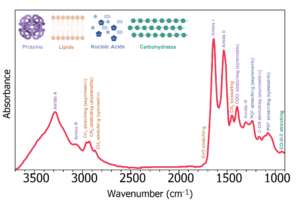
Figure 1: ATR-FTIR spectrum of Human serum.
A range of materials are available for the ATR crystal, and the decision of which one to pick is based on application area. ZnSe is suitable for routine analysis, however harder samples can cause the crystal to crack or shatter and strongly acidic or basic samples can cause toxic fumes. Germanium is suited to samples with a high refractive index and surface studies due to its smaller depth of penetration. The gold standard material for ATR crystals is diamond; it’s virtually indestructible, whilst offering high thermal conductivity for heated ATR-FTIR experiments.
Transmission FTIR spectroscopy is the most traditional method to analyse samples. Incident infrared light passes through the sample, and the amount which transmits through is measured producing an FTIR spectrum in %Transmission.
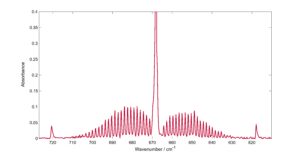
Figure 1: FTIR spectrum of CO2 gas
Transmission FTIR can be used for liquids, solids, and essential for gas phase measurements. Sample preparation is typically required for transmission measurements, solid samples may require dispersion in KBr and pressed into pellets, and IR transparent windows, such as CaF2, are required for measuring liquids.
The IR5 can also be configured to measure photoluminescence (PL) spectra in the mid-infrared region. For this measurement an excitation laser is required, which is focussed onto the sample. The sample’s PL emission is then optically guided into the interferometer and through to the detector. This technique is mainly used to look at MIR photoluminescence of rare-earths and semiconductors.
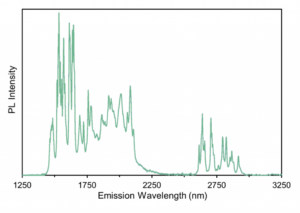
Figure 1: Infrared photoluminescence from erbium measured in the IR5 FTIR spectrometer
FT-PL spectrometers, employing interferometers and non-dispersive technology, offer improved sensitivity and more accurate signal representation for mid-infrared PL studies compared to traditional dispersive instruments. By capturing the full spectrum simultaneously, they reduce noise and maintain uniform spectral resolution.
The IR5 can host numerous other sampling accessories offering a full suite of FTIR techniques. For example, specular reflectance accessories which are particularly useful for analysing thin films. Diffuse reflectance infrared Fourier transform spectroscopy (DRIFTS) is excellent for collecting IR spectra from strongly absorbing samples with rough surfaces, such as powders.
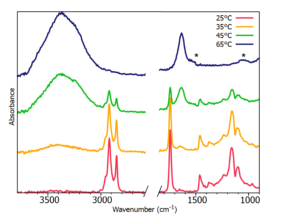
Figure 1: Temperature study on a water-in-oil emulsion
Accessories are designed for specific end user needs, for example heated ATRs can be offered to track phase transitions in samples. Liquid transmission cells are offered to allow for fast and easy application of the sample, and for cleaning between samples with huge benefits to sample throughput.
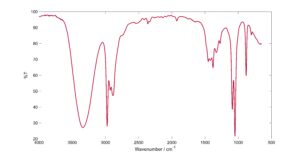
Figure 2: FTIR spectrum of ethanol with a 50 μm path length
Transmission sample holder for 50mm x 50mm filters and slides included with every IR5.

This holder also serves as a mount for a variety of vertical liquid and film holders and may also be used to support gas cells.
A variety of ATR options are offered for powder, liquid, film and bulk samples.

Single and multiple reflection ATR crystals are available such as diamond, germanium and ZnSe, as well as sandwich materials including ZnSe/diamond.
Accessory for routine measurement of liquids which accommodates horizontal liquid holders with a variety of optical path lengths.

Temperature-dependent FTIR measurements on films, liquids, powders and bulk samples can be performed using temperature-controlled ATR accessories, from room temperature up to >100oC

Unique to the IR5, a sample holder accessory is available for PL measurements using laser excitation.

The PL sample holder is placed in the sample position of the IR5 spectrometer. The laser used for excitation of the sample is mounted on the side of the IR5.
The IR5 comes with a DLaTGS detector as standard, with the option to configure for a second detector. Detector options include InSb, InGaAs, and MCT.
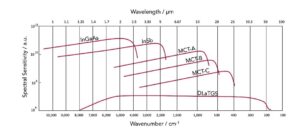
| Specifications | ||
|---|---|---|
| Standard Configuration | Spectral Range | 8000 - 350 cm-¹ |
| Sensitivity | SNR ≥ 20,000:1 | |
| Resolution | 0.5 cm-¹, 1 cm-¹, 2 cm-¹, 4 cm-¹, 8 cm-¹, 16 cm-¹, 32 cm-¹ | |
| Accuracy | 0.5 cm-¹ | |
| Source | High-intensity ceramic source | |
| Detector | DLaTGS | |
| Beamsplitter | Germanium coated KBr | |
| Hygroscopic Integrity | Integrated desiccants, electronic dry-membrane, embedded LCD and software hygrometers for maintenance-free operation | |
| Windows | KBr window exchangeable by user | |
| Operating Voltage | Universal mains input 100-240 VAC, 47-63 Hz | |
| Detector Upgrade | Second Detector | Additional detector fitted to the instrument optimising its spectral range Detector options include InSb, InGaAs, and MCT |
| PL Upgrade | Fourier Transform Photoluminescence Capability | External PL excitation laser mount, laser is freely exchangeable Dedicated PL sample holder for maximum signal-to-noise ratio Intuitive photoluminescence acquisition wizard in software |
| Sample Accessories | Transmission Sample Holder | Compatible with films and cuvettes |
| Attenuated Total Reflectance (ATR) | Basic and advanced ATR models available with a choice of crystal (diamond, Ge, ZnSe) | |
| Photoluminescence Sample Holder | Suitable for solid samples, powders, and liquids | |
| Others | Diffuse reflectance, custom and third-party accessories available | |
| Software | Miracle | Powerful and intuitive software for data acquisition, analysis and presentation, full control of all interferometer, amplifier, temperature and humidity monitoring |
| Measurement Types | Transmission, Absorption, Reflection, Kubelka-Munk, FT-PL | |
| Acquisition Modes | Live signal monitoring, single scan (including user-defined methods), kinetic series | |
| Dimensions | W x D x H | 660 mm x 540 mm x 300 mm |
| Weight | 37 kg |